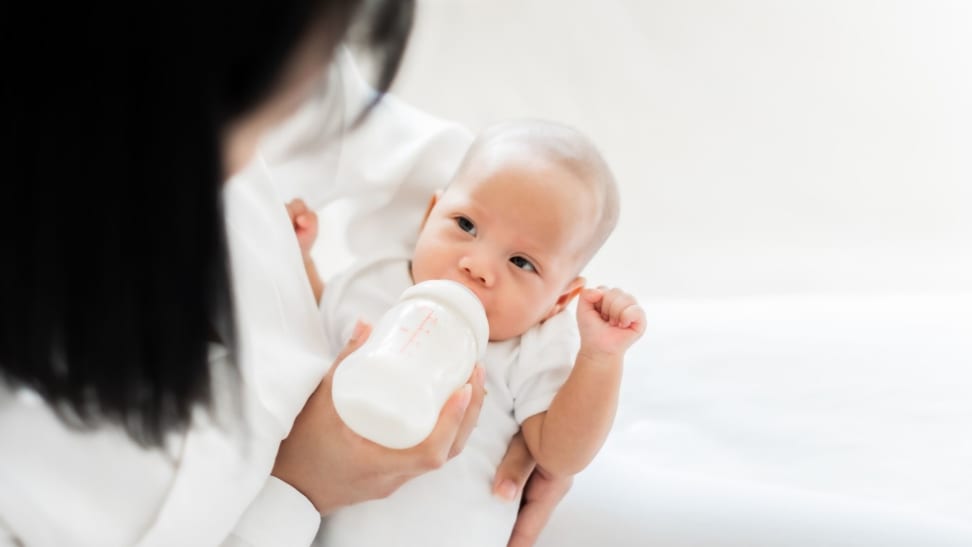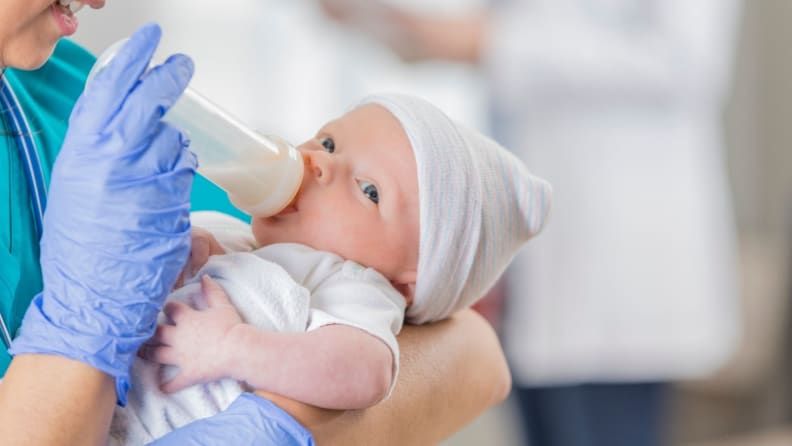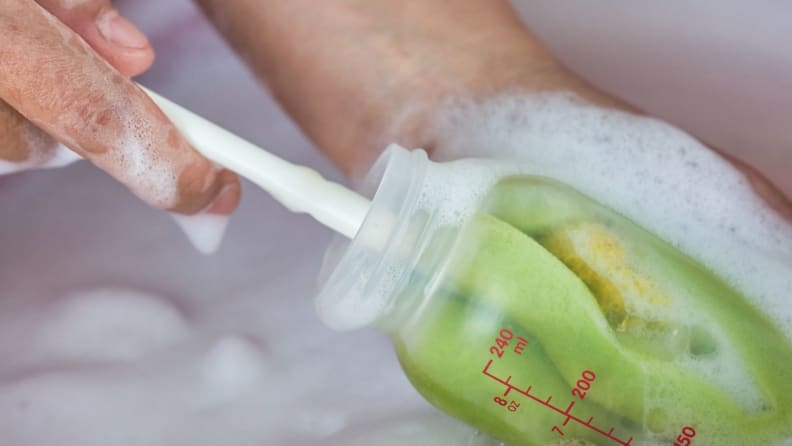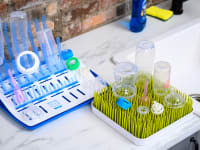 图片来源:盖蒂图像 /纳塔科恩机动
图片来源:盖蒂图像 /纳塔科恩机动
Recommendations are independently chosen by Reviewed’s editors. Purchases you make through our links may earn us a commission.
If you’re planning tobottle feedyour baby, you should be prepared for a whole lot of bottle cleaning. How someone so little can consume so much and so quickly may be one of the great mysteries of the universe. What their voracious little appetites leave behind are a whole bunch of dirty bottles.
Once you’ve done all your research and found the best baby bottle, you’re going to have to figure out how to keep them clean. If you listen to your mom or your grandmother, you might think that you need to sterilize your infant’s bottles on a regular basis but, as it turns out, things may be a whole lot more simple.
According toSmita Malhotra, MD, FAAP,位于洛杉矶的儿科医生和The Newborn Handbook: Your Guide to Bringing Home Baby,在大多数情况下,在热水中进行良好的磨砂膏或穿洗碗机的旅行应该是使宝宝的瓶子保持足够清洁以定期使用所需的一切。
“If your baby is healthy and over three months of age, and you have clean water in your home, regular sterilization isn’t anything you need to worry about,” says Malhotra. “That being said, knowing how to sterilize properly is important and there are times where it’s absolutely necessary.”
Here, we break down the whens and whys of sterilizing baby bottles and the best methods for getting the job done:
When should you sterilize a baby bottle?

如果您的宝宝生病了,过早或三个月以下,您应该对他们的瓶子进行消毒。
曾几何时,当我们无法持续使用清洁的市政水时,每次使用后,父母都需要对婴儿的瓶子进行消毒。今天,您不需要付出太多的努力,但是有时候建议进行彻底的消毒。这是您绝对需要对婴儿的喂养物品进行消毒的时候。
如果瓶子是新的
It’s always advised to give it a cursory sterilization when a new bottle arrives in your home. There’s no telling if other hands have touched the nipple, or if it fell on the floor. To be safe, give it a boil or a bleach clean to ensure it’s pristine.
If the bottle is second-hand or borrowed
当您找到交易或成为朋友的一些出色婴儿装备时,情况真是太好了。In both of these situations it’s crucial that you sanitize any of your baby’s feeding items, not only to get rid of any lingering bacteria from the previous owner, but to ensure that none others were picked up while in storage or on the second-hand shelves.
确保您选择使用的任何旧婴儿奶瓶不含BPA。2012年,美国食品药品监督管理局(FDA)禁止在针对12个月以下儿童的婴儿奶瓶中使用BPA,这是由于担心会影响儿童的发展。如果您使用的是较旧的塑料瓶,请确保它们在底部没有印在底部的回收7号,这表明它们含有BPA,否则没有任何消毒会使它们对您的孩子安全。
如果你的宝宝生病了
“If a baby has been ill or has any sort of viral or fungal infection, you definitely need to sterilize at that point,” says Malhotra. Since every illness is different, she recommends you talk to your child’s pediatrician as to the specifics regarding how long you’ll need to sterilize the bottle for, but if they havethrush,hand-foot-mouth,或任何病毒或细菌感染,灭菌是帮助它们康复的关键部分。
If a baby is premature or has health issues
If this is the case your child’s doctor will likely advise you on sterilizing their bottles, but both Malhotra and the CDC caution that any child with any sort of weakened immune system should have their bottles regularly sterilized.
If you do not have access to clean drinking water
在大多数情况下,在大多数国家,市政drinking water is safe. However, if your drinking water is in question—or if you are traveling to an area where you are unsure if the drinking water is safe—you should take precautions and sterilize your child’s bottle after every use.
How often should you sterilize a baby bottle?

Freshly washed or sterilized baby items should always air dry on a clean towel. Never rub or pat dry.
Malhotra说,如果您有一个带有热干燥周期或消毒环境的洗碗机,则不必采取更大的消毒步骤。她说:“您确实需要做最适合家人的事情,但总的来说,如果您有洗碗机,您可以避免定期灭菌的额外压力。”
Malhotra说,如果您要洗手,仍然不必经常进行绝育。
How to sterilize a baby bottle
清理之前,请确保您已经彻底清洁了孩子的任何喂食物品。请务必与该物品的制造商查看哪种方法对孩子的瓶子安全。
Boiling in water
所需的只是一个将水煮沸的锅!不用担心,塑料瓶和乳胶乳头可以安全地使用这种方法消毒。
- Fill a large pot with water.
- Disassemble all feeding items and place them in the pot, submerging and filling them with water to minimize floating. Be sure all of the pieces are completely covered with water.
- Put the pot over heat and bring to a boil.
- 将零件煮约5分钟(请务必检查制造商的建议)。
- Remove parts with clean tongs.
- After sanitizing, place the parts on a clean, unused dish towel or paper towel in an area protected from dirt and dust. Allow to air-dry thoroughly before storing. TheCDC recommendsthat you do not use a dish towel to rub or pat items dry because doing so may transfer germs.
Bleach
马尔霍特拉(Malhotra)说,如果您没有洗碗机或沸腾的人是一种选择,则漂白剂是另一种方法 - 尤其是在旅行时。
- Prepare a bleach solution of 2 teaspoons of unscented bleach per gallon (16 cups) of water in a clean wash basin.
- Submerge all items completely, checking that the solution touches all parts and there are no air bubbles in the bottles.
- 通过乳头孔挤压溶液。
- Soak items in solution for at least 2 minutes.
- Remove with clean hands or tongs. The CDC cautions against rinsing after sterilizing, adding that “germs could get back onto the sanitized items. Any remaining bleach will break down quickly as it dries and will not hurt your baby. This process is similar to what is done to sanitize dishes in restaurants.”
- 把物品放在一个干净、未使用的盘北京同为l or paper towel in an area protected from dirt and dust and allow to thoroughly air-dry before storing.
蒸汽清洁
在微波炉上进行蒸汽消毒以及是否安全这样做,有很多争论。马尔霍特拉(Malhotra)说,如果您正在寻找一种更快的方法来消毒孩子的喂养物品,那么蒸汽清洁剂并不是您的婴儿清单的必要条件,但可以节省时间。
“Boiling and bleach will absolutely do the trick, but [steam cleaners] do save time and I recommend them for parents who just don’t have the time to keep an eye on a boiling pot,” says Malhotra.
Each steam cleaner will be different, so it’s recommended to follow the manufacturer instructions to the letter.
Get the Baby Brezza one-step bottle sterilizer and dryer at BuyBuyBaby for $99.99
In the dishwasher
如果你的瓶子是dishwasher安全,那么我们对您有个好消息!您的设备最热的水设置和加热干燥周期是定期清洁瓶子并保持消毒的最佳方法之一。有几个步骤要遵循:
- 将所有瓶子零件完全分开。
- Rinse each part thoroughly with clean water and a scrub brush if needed to remove any milk particles.
- 将所有瓶子零件放在洗碗机的顶部架子上;较小的零件应该进入dishwasher-safe basketto ensure that nothing falls through to the bottom of your dishwasher during the wash cycle.
- Run the hot-water cycle for cleaning and "heat dry" for drying.
- Remove all bottle parts and let them dry on a clean dishcloth. Do not pat dry.
Get the OXO dishwasher basket in teal at BuyBuyBaby for $9.99
And for a good scrub by hand...

确保在洗瓶瓶时,请使用干净的刷子和盆地,仅用于此目的。
Before any sterilization, and in between, a good scrub in hot soapy water is critical. Here is how to get your baby’s bottles super clean every day of the week. After every cleaning, bottles should air dry on an area free of dust on a clean, dry towel.
The CDC specifies that it’s not only important to wash your baby’s feeding items thoroughly but to make sure that the basin you use and the bottle brush is sterile as well. To ensure this, be sure to use a bottle brush and a basin or bowl that are used exclusively for cleaning your baby’s bottles. They also recommend that you start with clean, washed hands.
- Take apart and separate all bottle parts including the nipples, caps, rings, and valves on each bottle.
- Rinse each item thoroughly to clear them of milk debris. Do not set them in the sink; instead put them in the bowl or basin you have set aside for this purpose.
- 用热水填充盆地,添加肥皂。
- Scrub each item carefully using a clean brush that is used only to clean infant feeding items. Be sure to get to the very bottom of the bottle.
- Squeeze and flush water through nipple holes to clear them.
- Rinse completely, either by holding items under running water, or by submerging them in clean water in a separate basin that is used exclusively for cleaning infant feeding items.
- 允许气干。
Get the Boon cacti bottle brush cleaning set at Target for $14.99
产品专家Reviewedhave all your shopping needs covered. Follow Reviewed onFacebook,Twitter, andInstagramfor the latest deals, product reviews, and more.
Prices were accurate at the time this article was published but may change over time.





